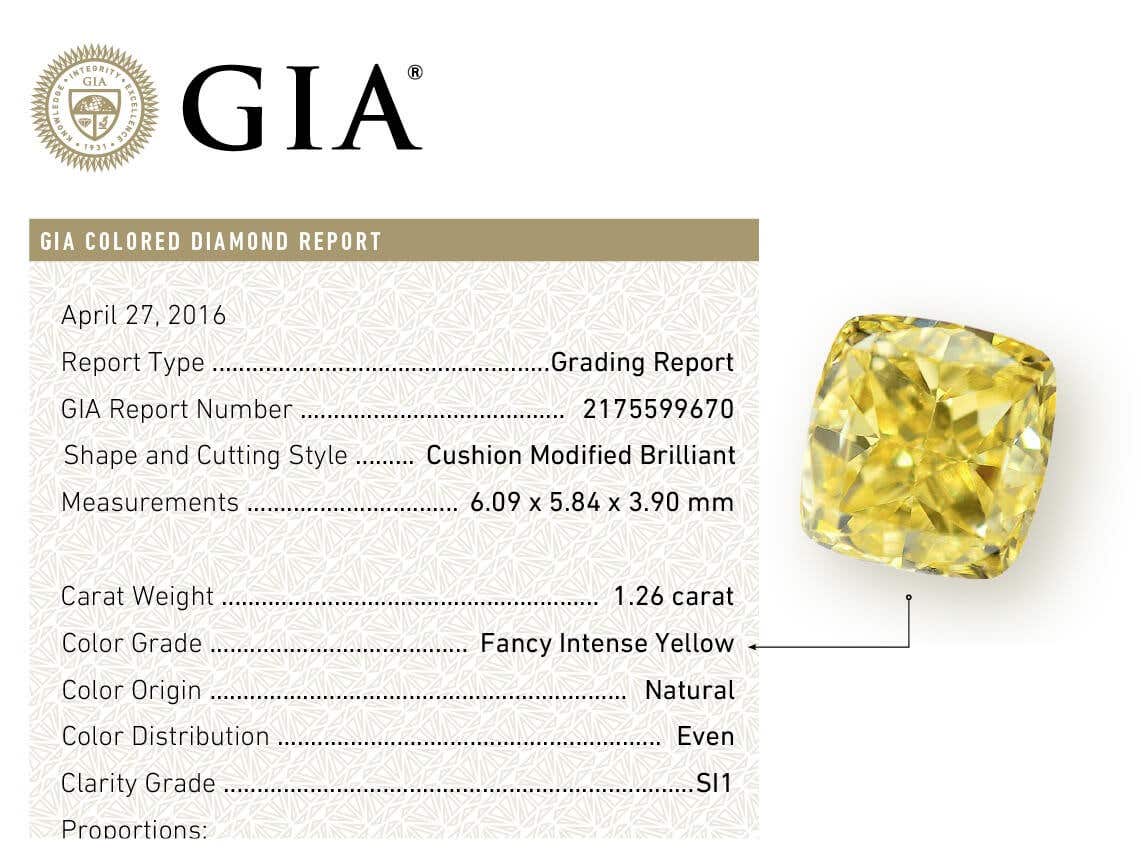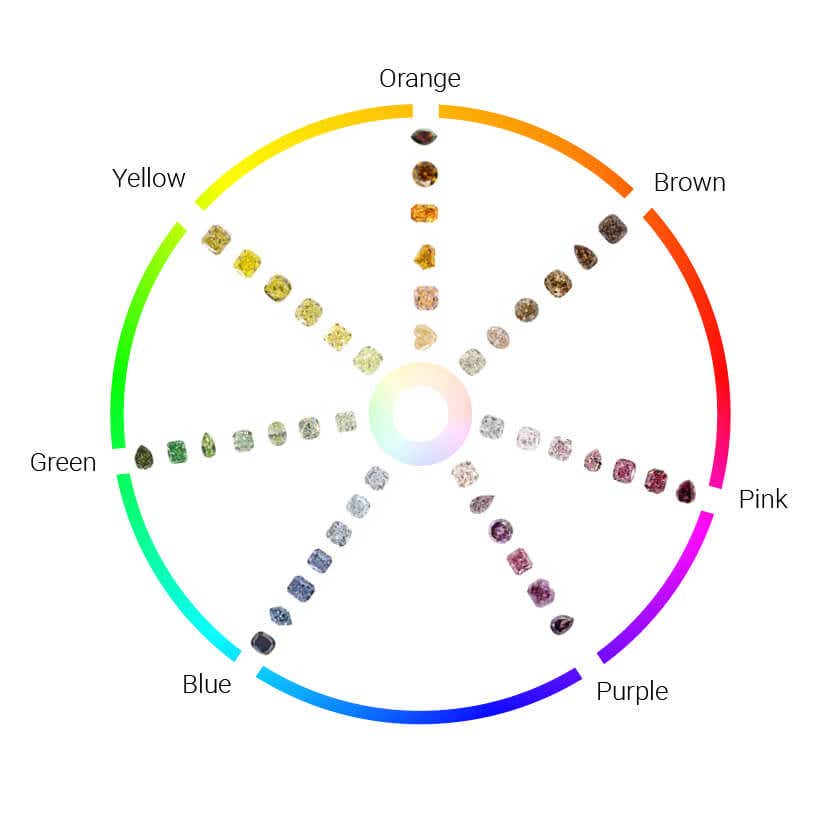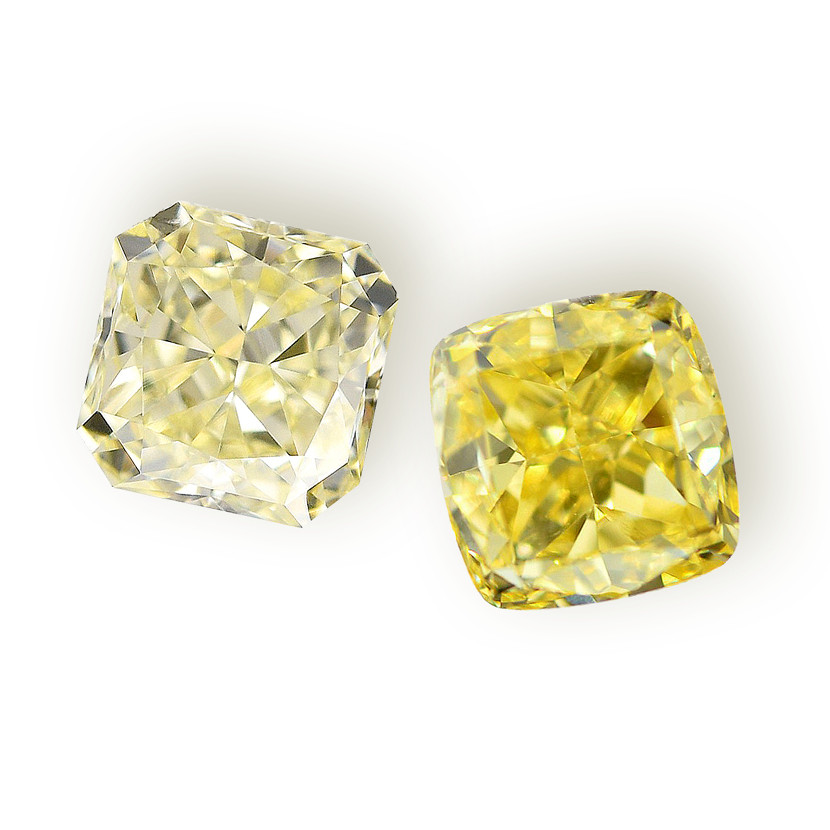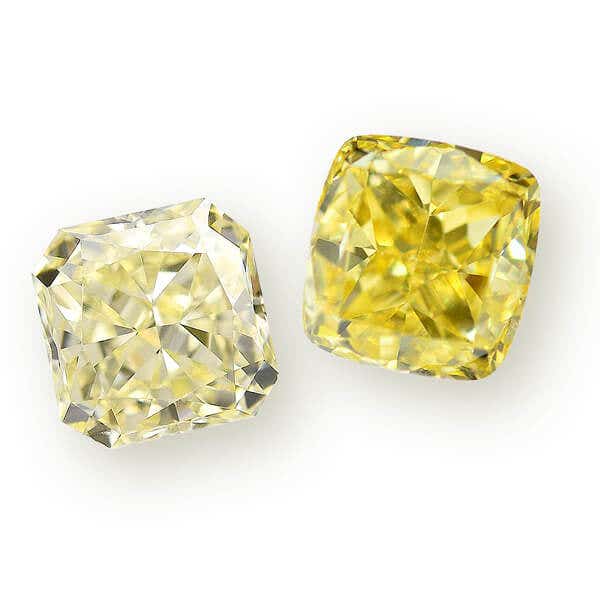Natural Yellow Diamonds Buying Guide: Rarity, Prices, Engagement Rings & Much More
Fancy Yellow Diamonds breathtaking beauty, bright shine, warm color, and the fact that they are rare but affordable for most people make them the perfect gift, the coveted engagement ring, and the ideal diamond, even for you. Naturally, yellow diamonds are a trendy and popular choice for easygoing and positive people who like to rejoice and spread the love.
Natural Yellow Diamond: How to identify and select the right yellow diamonds?
Are you looking to buy yellow diamonds? The technical aspect of recognizing and understanding the yellow diamonds includes several critical factors that affect a diamond’s grading and pricing. Here you will learn how to understand, identify, and select the right yellow diamond for you.
Natural yellow diamonds: How are they formed?
Like all natural diamonds, natural yellow diamonds are formed in a long and fascinating process in the belly of the earth. Just as challenges and difficulties toughen us and make us stronger in our own lives, the world's most mesmerizing diamonds too are subjected to harsh conditions of 1,000 to 2,000 degrees centigrade combined with tremendous pressure at a depth of 150-200 km below the Earth's mantle, in a continuous process spanning over millions and billions of years. All this results in the formation of a rare & beautiful crystal with unique qualities, such as a natural shine, high penetration of light, extraordinary strength and toughness, all of which making its cost skyrocket.
The yellow diamond actually gets its distinct color by 'sullying' the pure carbon mineral crystal with nitrogen molecules. The nitrogen molecules linked to the carbon molecules generate a yellow tint of various intensities and shades, in hundreds of potential combinations that often differ depending on the origin of the diamond and the chemistry that occurred during its formation.
Fancy yellow diamond: Defining the color
According to Gemological Institutes, the characteristics of a diamond are not obvious or simple to determine. In fact, it takes careful and professional work reserved for specialists who can detect and distinguish the seemingly minute differences that make each diamond special and unique, with its own features, story and pricing.
The diamond’s characteristics are defined by four main criteria called the 4 C'S - Color, Carat, Clarity & Cut, which serve as parameters for identifying and cataloguing diamonds (including white diamonds) based on predetermined metrics and scales, and are specified in the diamond certificate. In the niche of fancy colored diamonds, the most important parameter is the color because it has the most impact on the diamond’s rarity and therefor its pricing. To explain the effect of the 4 C'S on the definition and pricing of yellow diamonds, we will start with the color parameter.

Defining the yellow diamond’s color based on three main criterions:
The color parameter alone, despite being only 1 out of the 4 Cs, consists of three main grading scales: Hue, saturation, and tone. The effect of these parameters on the diamond’s definition and pricing is key and important, since the factor that most influences a diamond’s price is its color. Subsequently, there are hundreds of combinations of yellow diamonds and the price range is vast. For example, a brownish tint will reduce the value of a yellow diamond, while a green, orange, or gray tint will significantly increase its value. Even without any additional tint, the stronger the color intensity, the higher the diamond’s value.
Hue - The diamond’s primary color (yellow in this case), with a total of 27 defined colors, some of which consist of a combination of two colors put together, like Orange Yellow. Color combinations represent a primary hue and secondary hue (Modifying Color & overtone) - when a diamond has more than one color, it’s very important to remember that the order in which they appear is crucial – the last color is actually the primary hue and the previous colors represent the secondary hue. But in addition to the order of the colors, the way they are mentioned in the certificate is equally important with respect to the presence of the overtone in the diamond.
For example, Greenish Yellow is a diamond whose primary hue is yellow (75%), while the secondary and relatively scarcer hue is green, with only 25%. However, the label “Green Yellow” indicates a more balanced division between the two hues, with yellow remaining the primary hue with 60% and the green being the secondary hue with a noticeable presence of 40%.
*This example is for illustration purposes only and does not represent an actual percentage.

Saturation – The definition of saturation in yellow diamonds and fancy colored diamonds in general is manifested through the color’s intensity, presence, and strength. The color intensity scale begins with bright pastel colors and ranges up to live, dark and deep colors. The intensity scale of yellow diamonds is divided into 9 levels as follows: faint, very light, light, fancy light, fancy, fancy intense, fancy dark, fancy vivid, fancy deep.

Tone – The tone represents the brightness or darkness level of the color or shade. The scale begins with “faint” and gradually reaches higher darkness levels, essentially merging slowly with the intensity scale.

Another factor worth considering when buying a yellow diamond is the distribution of color within the diamond. Here, it is binary only: Even & Uneven.
Appearance of yellow diamonds in the white diamond scale
Unlike fancy colored diamonds, the color of white diamonds (colorless) is examined with a standard color scale of the Gemological Institute of America (GIA), which measures and rates the presence or absence of color in the diamond’s crystal, whereas the less color there is the more expensive it becomes. This because most white diamond have a light shade of yellow or brown while white diamonds with no tint whatsoever are considered rarer.
Grades D, E, and F indicate a ‘purer’ colorless diamond compared to diamonds graded K-M and N-R, which have a slight shade of ‘pale yellow’ or ‘very light yellow’ and are therefore not as valuable.

The color intensity scale for the classic yellow diamond (included in the fancy colored diamond category) begins with grade “S” on the white diamond scale, where the yellow shade becomes noticeable and rarer, and the stronger the color the higher the diamond’s value. Although the color scale is not the official gauge for measuring fancy colored diamonds, the area of overlap between the color scale of white diamonds and the intensity scale of fancy colored diamonds enables us to observe the mobility in rarity and pricing of diamonds across the scales.
Yellow Diamond pricing: Carat, Clarity & Cut
Apart from the color definition, which constitutes the central and the most significant aspect when pricing natural yellow diamonds, there are three other criterions that apply to white diamonds as well - three of the four C's: Carat, Clarity & Cut, which as well influence the pricing of yellow diamonds.
Carat - The carat parameter refers to the diamond’s weight. 1 carat is defined as about 0.2 grams, or 100 points. In general, pricing by carats increases the price of heavier diamonds compared to smaller diamonds with the same values of clarity or shade.
For example, a fancy yellow diamond weighing one carat will cost around $4000-$5000, while 100 identical fancy yellow diamonds with the same clarity, weighing 0.01 carats each and together comprising a whole carat - will cost together about $900-$1,000. In the case of rarer fancy colored diamonds the differences might be much greater.
Clarity - While most of us can identify a diamond’s color and assess its size by merely looking at it (assuming we have a basic understanding of diamonds), the clarity parameter is an area reserved for the professional diamond experts and gemologists institutes that are able to detect the smallest flaws, even those that are invisible to the human eye, and grade the diamond according to its level of internal clarity.
The GIA’s clarity scale is divided into 11 levels that are then divided into 6 groups. Compared to the slight difference in prices between each grade level, the price differences between each group are more significant. Yellow diamonds are known for their relatively natural clarity and therefore can be found in high clarity grades of the VS group and above.
Diamond clarity grades, according to the GIA:
IF, VVS1, VVS2, VS1, VS2, SI1, SI2, SI3, I1, I2, I3.
Group Classification:
FL – Flawless
IF – Internally Flawless
VVS1/VVS2 – Very, Very Slightly Included
VS1/VS2 - Very Slightly Included
SI1/SI2 – Slightly Included
I1/I2 /I3 - Included
FL is the highest clarity grade and refers to flawless diamonds, whereas I3 is the final and lowest grade that refers to diamonds with visible inclusions.
Cut – Although many believe that Cut and Shape are two terms that refer the same parameter, they are actually two separate features that reflect different yet complementary parameters.
This term refers to the way in which the diamond polisher cuts the diamond shape and whether the level of a diamond’s cut, polish, and symmetry is high, medium or low. Prices do not vary drastically between average cuts, but rather between poor and excellent cuts.
A good cut will highlight everything that raises the diamond’s value, be it the right shape for the color, the right size, the polish that brings out the sparkling shine, symmetry, and so on.
It isn’t absolutely necessary to insist on the best cut, but it is recommended not to settle for a poor cut that renders the diamond lifeless and lowers its value.
Shape - Although it is not one of the 4 C's, the shape the diamond is cut into can affect the way light penetrates the diamond, and accordingly, affect its hue. For example, when white diamonds with a minor yellow tint, which are naturally graded from D to Z on the white diamond scale, are cut into the proper shape (usually Radiant), they can acquire a more yellow tint when looking at them from above, and their price per carat will rise accordingly.
Other shapes: Cushion, Pear, Oval, Heart, Round, Marquise, Emerald, Princess and more.
Are yellow diamonds rare?
The answer to this question lies in the following figure: for every single carat of fancy colored diamond there are 10,000 carats of white diamond. The rarity of all diamonds in the colored diamond spectrum is unquestionable and this raises the appeal of these beautiful diamond crystals in inverse proportion to their numbers in the market - the rarer the diamond, the higher the demand for it and the higher its price.
Yellow diamonds are the most common of all colored diamonds, constituting nearly 60% of this category, with an estimated ratio of one carat of yellow diamond for every 16,500 carats of white diamond. However, each diamond is different and its values are what determine its rarity - usually the weak tints are less rare, whereas yellow diamonds with strong hue and saturation are considered very rare, such as the Fancy Vivid Yellow diamond.
So even though they’re not as rare as green, blue, orange, or red diamonds, yellow diamonds are still considered rare, while some yellow diamonds are even rarer due to their unique and stronger color.
What are Canary Yellow Diamonds and Zimmy Diamonds?
In addition to the international names given to diamonds by the Gemological Institute of America (GIA), which are used by the global diamond industry to identify the characteristics of each diamond, there are also nicknames coined over time to create sub-categories in cases where another means of identification is needed to further emphasize the uniqueness and rarity of the stones. Canary Yellow diamonds and Zimmy diamonds are an example of this:
Canary Yellow diamonds are a sub-category within the yellow diamond group, intended for dividing and differentiating between bright yellow diamonds or yellow diamonds with a different shade that isn’t purely yellow on the one hand, and yellow diamonds with a strong and rare shade such as the Vivid Yellow and Intense Yellow diamonds on the other hand. Canary diamonds, named after the canary, a sweet yellow breasted bird, are rarer and therefore more expensive than other yellow diamonds. Until recently they were the only ones defined as Fancy Yellow diamonds. Today, some define shades of greenish yellow or brownish yellow as a fancy yellow diamond and the demand for this type of diamond increases every year, with more and more breathtaking diamond jewelry designed around these colors.
In contrast to Canary diamonds, which highlight the intensity and purity of the color, Zimmy diamonds are yellow diamonds originating from the Zimmy mine located in Sierra Leone, which is known for the special diamonds mined from its soil, usually Vivid Yellow diamonds, renowned for their deep and unique shade.
Yellow diamonds: trendy, energetic and perfect for engagement rings!
After reviewing all the important technical explanations that will allow you to examine the stone and make an informed decision regarding your favorite fancy yellow diamond, it's time to talk a bit about the trendy, romantic, and symbolic aspect of the yellow diamonds and why you should buy them?
In the past, due to their relative abundance within the colored diamonds category, yellow diamonds were considered less popular. After all, in the world of diamonds rarity is what matters most, and blue, green, and pink diamonds stole the show. But in recent years, due to economic events and international decisions in the fashion world, the positioning of yellow diamonds completely changed and they are now considered a hot trend that is here to stay.
In 2009, as the world recovered from the financial crisis of 2008 and faced an escalating security situation, leading fashion figures made a decision – yellow is the best color for lifting the spirits, cheering up, and restoring the confidence of the people.
For many people, the color yellow represents nature, sunlight, dandelions, mustard, and yellow mimosa. It symbolizes springtime and tranquility and instills a sense of warmth, joy, and optimism - precisely what the world needs at a time like this. In the same year, a very apparent shift toward the color yellow had occurred; Catwalks of major fashion companies in Milan and Paris began to boast a yellow theme: shoes, jewelry, and even home furnishings got a fresh yellow twist as part of a global trend aimed at making everyone happy.
In the diamond industry yellow diamonds began to gain popularity also. On the one hand, they are part of the same trend that took over the world, gradually making yellow diamond jewelry a must-have item, as celebrities and leading jewelers chose them for red carpet events. On the other hand, due to their relative abundances compared to other colored diamonds, their price was relatively lower and thus they became a rare, fashionable, beautiful, and yet affordable choice for everyone.
Yellow diamond engagement rings
"How can you make two months' salary last forever?" This single sentence from an advertisement released by De-Beers in 1997 can help us understand the great significance humans ascribe to diamonds.
Besides the fact that diamonds are a natural resource created through a process of billions of years deep in the underground; and that this material is very strong and doesn’t fade or break; and that they’re so rare – diamonds are first and foremost a symbol of love and its eternity.
Whether this beautiful icon is the result of a genius marketing campaign by De Beers that began as early as 1938, or the result of a natural process that human civilization has underwent, thereby attributing the whole beauty of love to this rare, ancient, and breathtaking stone, the status of diamonds as the default choice is no longer reserved only for royalty and nobility, but rather is available to anyone, or as the advertisement says: "How can you make two months' salary last forever?"
Yellow Diamond Engagement rings encompass all the deep meanings we mentioned so far, and much more.
The color yellow symbolizes light and optimism. In the spiritual-energetic world it is considered to be the color that symbolizes the entire range of emotions. In addition, this wonderful color’s natural brilliance makes engagement rings with yellow diamonds look more sparkling, brighter, and present, thanks to the wonderful reflection of light it imparts. However, there is one important parameter that makes engagement rings with yellow diamonds an even more worthwhile choice - the price. The price of such a ring will be lower than the price of an engagement ring with blue or pink diamonds, for example. Thus, despite its rarity, it becomes an affordable colored diamond for young couples seeking to find the perfect engagement ring that will both express the uniqueness of their love and at the same time fit their budget.








